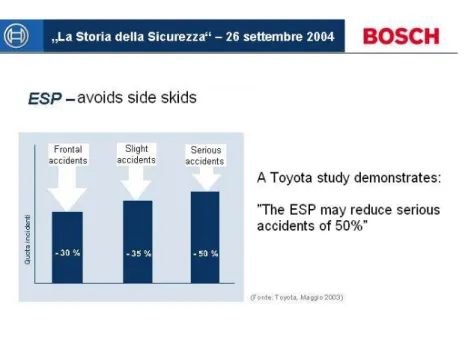Chapter 1
Introduction
Nowadays many cars are provided with electronic systems able to prevent dangerous vehi-cle motions (oversteer or understeer1) in order to improve vehicle handling and stability.
Several reasons can cause an unforeseen vehicle behavior, for example the excessive cor-nering speed or the unexpected change of the road grip. These systems, called Active Yaw Control [8], can introduce a yaw moment using various actuator concepts. The stability system intervention in fact can be directed towards the brake system (ESP), the steer angle (of both front and rear wheels), the active suspensions (dynamic drive). In any case the most common among these systems is surely the “ESP” (Electronic Stability Program). This system is very safe, but its action can be uncomfortable or even disappointing for some particular applications, as for example when installed in sport cars. Since the distribution of the engine torque between the front and the rear axle affects the vehicle handling we analyzed the opportunity to exploit this phenomenon in order to increase vehicle safety. In this research, made in cooperation with the “Delft University of Technology” (The Netherlands) within the “Socrates” project 2003-2004, we studied both the possibility to substitute a traditional ESP with a new generation of stability systems, based on the re-distribution of drive torque, and the possibility to use these systems together.
We analyzed the effects caused by the action of these systems in terms of safety, perfor-mance and comfort.
In the second chapter of this report the theoretical vehicle model we used is illustrated and in the third chapter the principal aspects of the “Simulink” model we built to simulate the car behavior are described. The fourth and the fifth chapters deal with the ESP and
1With the terms oversteer and understeer we will not refer to rigorous definitions but we want to
indicate a car behavior which makes the car drive along respectively a wider or a smaller curve radius than the corner radius the driver is used to expect.
the “Redistribution of Torque System” respectively. In the sixth and seventh chapter we illustrate the results obtained by means of the simulations, and in the end we present our conclusions in the eighth chapter.
1.1
Electronic Control Systems History
Until the second half of the 70’s the car motion was controlled just by the driver’s skills. No active-safety devices had been designed before and only the quality of the mechanical project influenced the vehicle safety and stability.
In fact the main contribution to the development of the systems which currently are very common as the “ABS” (Anti Brake-locking System), the “ASR” (Acceleration Skid Control) or the “ESP” (fig. 1.1) was given by the incredibly fast improvement of the electronic components.
Figure 1.1: Main safe systems installed on the vehicles
The first application of this spreading technology was the “ABS”, installed at first on the Mercedes S Class in the 1978 and subsequently on the BMW Series 7. In 25 years this system has been improved very much and it has become a standard equipment for almost the 70% of the production cars.
Year Weight [kg] Number of components Memory [kByte]
1978 6.7 140 2
1995 4.9 40 8
1999 2.6 25 24
2003 1.6 16 128
The second step was the “ASR”, which is a system that does not allow the tyres to slip in case of excessive acceleration. This device, which is interfaced with the “ABS” CPU was thrown on the market in the 1986.
In the end the modern state of art of the electronic control systems is the “ESP”. It was installed at first on a Mercedes in the 1995.
Figure 1.2: Evolution of the electronic systems
By means of this device it is possible to control directly the vehicle motion, the car trajectory, not only the tyre grip. The ESP is spreading very quickly, even faster than the ABS did. In the 2003 it was already installed on almost the 30% of the new vehicles in Europe, however with very different percentages in each country. For example in Germany the 50% of the production vehicles are currently provided with the ESP, but this value decreases at 30% in France, 25% in Spain, 20% in UK and only the 14% in Italy. This last statistical information is very disappointing if we take into account the fact that several studies demonstrate that the ESP can prevent many accidents.
Figure 1.3: Estimated influence of the ESP on the number of accidents
The ESP can be very helpful in order to achieve the target, intended by the UE, to halve the number of victims caused by the car accidents (currently in Europe there are 1.3 millon of accidents each year and the victims are almost 40000).
In the near future the ESP will be interfaced with the active steer system (Bosch is developing this system in cooperation with BMW, which is already providing its luxury vehicles with this device), such a way to make the stability control system faster, safer and more comfortable.

